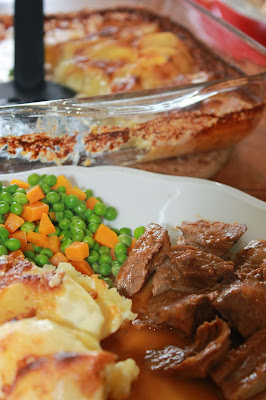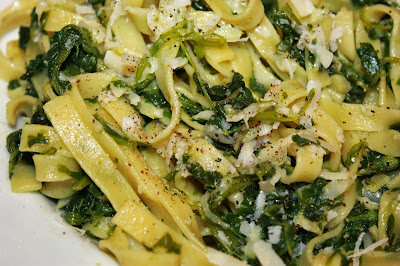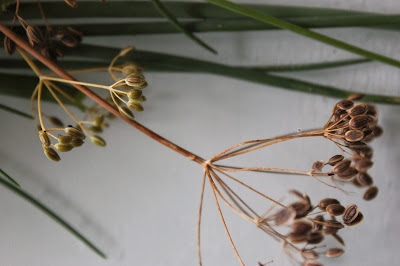A vivid childhood memory from my growing up in New York City is my mother proudly presenting her potatoes au gratin--small cubes smothered with Velveeta cheese. It was gooey, bright orange, and quite tasty. While living in Grenoble, the capital of the Dauphiné, I found out that this dish like so many others varies per the chef. The pristine version of Gratin Dauphinois contains no cheese, supposedly because the poor could not afford such adornment. Some insist on using milk and not cream. However, I will never forget our host at a dinner party saying as she gave her shoulders a little shrug in that perfect French manner, Some make this with just milk, but it is so much better with cream. Is she ever right!
Some additional tips were garnered from a visiting chef on a TV program hosted by Joël Robuchon: infusing the cream first with a bit of bouquet garni and garlic and then simmering the potato slices in this cream before baking.
For four servings, you will need two large potatoes, 16 fluid ounces/473 ml of heavy cream, a peeled and halved clove of garlic, a tiny sprig of thyme, a few bits of a bay leaf, and a sprig of parsley.
Preheat oven to 350 degrees F/177 degrees C. Put the herbs and garlic in a medium saucepan along with the cream. Bring to a simmer and cook gently for a few minutes. Meanwhile peel and slice the potatoes 1/4 inch thick. Add the potatoes to the cream and simmer until they are just about tender, but not yet fully cooked (usually takes about five minutes, but test with a tip of a sharp knife). Remove the herb sprigs.
Pour the whole lot into a baking dish.
Bake for about forty minutes until the taters are engorged with cream, and the whole thing is golden brown and crusty. This dish is so rich and scrumptious, I could entertain having it for dessert. Alas, we decided to serve a pot roast of lamb with it.
There was a quite a lot of green peppers remaining even after making Bell Peppers Stuffed with Toulouse Sausage/Brown Rice/Parmesan. Since there were still a few tomatoes from the potager, I made Piperade.
The very last of the tomatoes were used as top dressing for macaroni and cheese. The Calm One makes an excellent stove-top version which includes three different cheeses, three kinds of pasta, cream, and Saucisses de Strasbourg. I spread it evenly in a broiler-proof pan. The macaroni was covered with sliced tomatoes, topped with grated cheese, and then broiled for several minutes until the tomatoes were soft and their juices running a bit while the cheese was merrily bubbling.
There is a nice amount of onions harvested from our potager stored in our root cellar so Soupe à l'Oignon Gratinée is a no-brainer.
The surplus spinach harvest from this past spring which was frozen is now coming in handy. Defrosted, chopped spinach (made originally with garlic and olive oil) is heated in the pot in which some tagliatelle was boiled. The pasta is added back along with a couple tablespoons of reserved, cooking water. Simmer for a minute or until most of the water is gone. When serving, top with freshly grated Parmesan and add salt and freshly ground black pepper to taste.
I finally got around to growing dill this spring, but because it was a dwarf variety I did not realise that it needed vigorous pinching. Therefore they never developed into bushy, ferny plants. Instead they went to seed rather quickly. The greener the seed is, more the taste is similar to fresh dill leaf. Completely dried, brown dill seed tastes more like caraway seed which substitutes well for dill leaf in Potato/Onion Soup with Herbs, Crème Fraîche, and Saucisses de Strasbourg.
The greener seeds is a nice substitute for parsley in Linguine with Garlic/Capers/Parmesan.
In the garden, I am focused on dividing four-year-old clumps of Irises. If Irises become too crowded, their flowering is sharply reduced. Preparation includes pulling up dead leaves and clipping the remaining to about six inches above the ground.
The main source of colour in the flower garden is being provided by Japanese anemones.
A yellow, single-petaled dahlia imparts a soft glow.
The orange red fruits of Lily of the Valley adds a lovely autumnal accent.
À la prochaine!
Some additional tips were garnered from a visiting chef on a TV program hosted by Joël Robuchon: infusing the cream first with a bit of bouquet garni and garlic and then simmering the potato slices in this cream before baking.
For four servings, you will need two large potatoes, 16 fluid ounces/473 ml of heavy cream, a peeled and halved clove of garlic, a tiny sprig of thyme, a few bits of a bay leaf, and a sprig of parsley.
Preheat oven to 350 degrees F/177 degrees C. Put the herbs and garlic in a medium saucepan along with the cream. Bring to a simmer and cook gently for a few minutes. Meanwhile peel and slice the potatoes 1/4 inch thick. Add the potatoes to the cream and simmer until they are just about tender, but not yet fully cooked (usually takes about five minutes, but test with a tip of a sharp knife). Remove the herb sprigs.
Pour the whole lot into a baking dish.
Bake for about forty minutes until the taters are engorged with cream, and the whole thing is golden brown and crusty. This dish is so rich and scrumptious, I could entertain having it for dessert. Alas, we decided to serve a pot roast of lamb with it.
There was a quite a lot of green peppers remaining even after making Bell Peppers Stuffed with Toulouse Sausage/Brown Rice/Parmesan. Since there were still a few tomatoes from the potager, I made Piperade.
The very last of the tomatoes were used as top dressing for macaroni and cheese. The Calm One makes an excellent stove-top version which includes three different cheeses, three kinds of pasta, cream, and Saucisses de Strasbourg. I spread it evenly in a broiler-proof pan. The macaroni was covered with sliced tomatoes, topped with grated cheese, and then broiled for several minutes until the tomatoes were soft and their juices running a bit while the cheese was merrily bubbling.
There is a nice amount of onions harvested from our potager stored in our root cellar so Soupe à l'Oignon Gratinée is a no-brainer.
The surplus spinach harvest from this past spring which was frozen is now coming in handy. Defrosted, chopped spinach (made originally with garlic and olive oil) is heated in the pot in which some tagliatelle was boiled. The pasta is added back along with a couple tablespoons of reserved, cooking water. Simmer for a minute or until most of the water is gone. When serving, top with freshly grated Parmesan and add salt and freshly ground black pepper to taste.
I finally got around to growing dill this spring, but because it was a dwarf variety I did not realise that it needed vigorous pinching. Therefore they never developed into bushy, ferny plants. Instead they went to seed rather quickly. The greener the seed is, more the taste is similar to fresh dill leaf. Completely dried, brown dill seed tastes more like caraway seed which substitutes well for dill leaf in Potato/Onion Soup with Herbs, Crème Fraîche, and Saucisses de Strasbourg.
The greener seeds is a nice substitute for parsley in Linguine with Garlic/Capers/Parmesan.
In the garden, I am focused on dividing four-year-old clumps of Irises. If Irises become too crowded, their flowering is sharply reduced. Preparation includes pulling up dead leaves and clipping the remaining to about six inches above the ground.
 |
| Dead leaves needing to be removed can be seen in the upper right. |
The main source of colour in the flower garden is being provided by Japanese anemones.
A yellow, single-petaled dahlia imparts a soft glow.
The orange red fruits of Lily of the Valley adds a lovely autumnal accent.
À la prochaine!


















